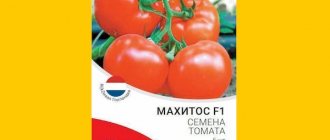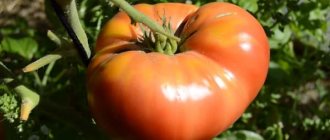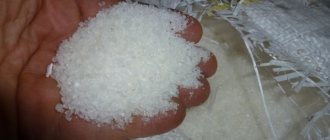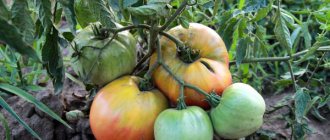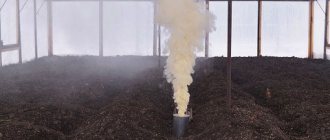Mikado pink is one of the best varieties in all respects. The size of the bush is tall, up to 120 cm. The name translated from Japanese means imperial title. A variety with long fruiting, beautiful fruits and bush, looks very rich, taste is excellent. Due to the fairly dense consistency of the pulp, this variety is suitable for many types of processing and preparation of various dishes.
Mikado pink bears fruit for a long time, right up to frost. This is one of the most productive delicious varieties. Fleshy fruits have a balanced tomato taste. The disadvantage of this variety is the impossibility of canning the whole thing due to its large size.
In Central Russia (in the Moscow region), the variety is grown in a greenhouse. Up to 12 kg of fruits are collected from the bush. The variety has passed state tests and has confirmed characteristics. This variety can also be grown in open ground.
The history of the creation of the tomato variety Mikado pink
For several years in a row, a group of professional breeders worked on creating the Mikado Pink variety. The authorship was shared by: Gavrish S.F., Mreev V.V., Amcheslavskaya E.V., Degvtsova T.V., Volok O.A., Artemyeva G.M., Redichkina T.A.
- The applicant of the variety is LLC "Gavrish Breeding Firm"
- The originator of the variety is Gavrish Breeding Company LLC, Moscow.
In 2013, the variety was ready for testing. He was put to work and for two years, 12 breeding stations across the country studied varietal characteristics and characteristics. The date of registration of the variety with inclusion in the register of selection achievements is 2015.
Many experienced vegetable growers are perplexed about the novelty of the variety. The fact is that the name “Mikado” has been around since the middle of the last century. With just one memory, everyone knew that these were pink, tasty and sweet tomatoes.
There is information that the Mikado comes from the Czech Republic. It was from there that the seed was brought and then the selection continued.
Description
The Cultivar Register describes the "Mikado" tomato as:
- salad:
- mid-early;
- indeterminate;
- pink;
- flat-round.
Characteristics of the bush
Indeterminate growth of the variety means that the shoot does not end with a flower cluster, but continues to grow. By autumn, “Mikado pink” reaches two or even more meters. The bush rests on the ceiling of the greenhouse and the grower is forced to pinch it.
If you form it into two shoots, and you don’t need more, then the Mikado will get dense, powerful, two fingers thick. Such a shoot can easily support a decent harvest of large fruits.
The leaf is green, medium in size, potato type.
Fetal characteristics
The fruit of the “Mikado pink” variety is flat-round in shape. During the ripening period, it bears a green spot on the stalk. Then it gradually dissolves, and the fruit gains pink colors.
The average weight of a tomato according to the register is 300-360 g.
According to reviews from gardeners who grew the variety, this figure is very underestimated. Vegetable growers claim that the average fruit is more than 400 g. At the same time, it is quite possible to get tomatoes weighing up to 1000 g. The largest fruits emerge from the lower clusters. Higher up they become smaller.
Fruit "Mikado pink":
- flat-round;
- ribbed;
- medium in density;
- with low seed content;
- has more than 6 seed nests.
The content of organic acids and sugars is so impeccable that the tasting results when testing the variety were rated “excellent”. The pulp of the fruit is fleshy, sugary and very pleasant to the taste. The skin is moderately dense and edible.
Distinctive features of the varieties
Three varieties of Mikado are registered in the Russian variety register. They are all different varieties, but with the name "Mikado". Of course, they have their own characteristics and taste:
- “Mikado pink” is the one described in the article;
- “Mikado Chocolate” is included in the register in 2022. The fruit, when fully ripe, is brown, strongly ribbed, and flat-round. The average yield is 13.5 kg per square meter, and the weight of the fruit is 200 g. The taste is “excellent”;
- "Mikado is brown." Flat-round with medium ribbing. Weight ranges from 150-200 g. The variety is assigned a yield of 8.7 kg per m2. The taste is excellent.
By and large, these varieties, except for the name, have the same thing only in that the last two have the same group of authors and all varieties are indeterminate.
Mikado red
Mikado red tomatoes of the middle ripening period have excellent taste. An indeterminate plant with a potato leaf shape, suitable for open and closed growing methods. The bush grows more than 1 m in height. The fruits are tied together in tassels. The bush is formed into 1 or 2 stems. A distinctive feature of the Mikado red tomato is its resistance to diseases.
The color of the fruit does not correspond slightly to the name of the variety. When ripe, the tomato turns dark pink or even burgundy. The shape of the fruit is round, strongly flattened with large folds of the walls at the point where the stalk is attached. The pulp is dense, with up to 10 seed chambers located inside. The average weight of the fruit is 270 g. The pulp contains up to 6% dry matter.
There is no point in considering a full description of the Mikado red tomato, since the conditions for caring for the crop are the same as for its fellows. The variety is suitable for cultivation in any area except Siberia and the Far Eastern region.
Characteristics
The Mikado pink tomato deserves attention. Its taste is well known to all gardeners who grew the variety.
Advantages and disadvantages
Listing the advantages of the variety, we can focus on the following positions:
- large-fruited;
- excellent taste;
- sweet;
- fleshy;
- suitable for fresh consumption and processing.
As disadvantages:
- the need for tying up shoots and fruits;
- the color of processed products is pale. To improve, you need to add rich red tomatoes.
In fact, these shortcomings cannot be considered disadvantages, but rather properties of the variety.
Ripening time and yield
Mikado pink mid-early variety. It takes 100-105 days from full germination to fruit ripening.
The tomato is intended for production under film covers, therefore, in open ground the timing may be shifted. Only the southern regions can afford to grow the variety in the garden.
The tomato yield is within the range of 13.5-14 kg per square meter. meter of greenhouse area. Since two bushes can fit in this area, the vegetable grower will take 6-7 kg of tomatoes from one bush. Vegetable growers describe that from a bush you can easily take 3-4 very heavy fruits, 5-6 smaller ones and several fruits weighing up to 150 g.
Resistance to diseases and pests
When registering the variety for the registry, experts did not indicate the special resistance of the Mikado Pink variety to any tomato diseases. This means that it is affected by all tomato diseases in the same way as any other variety or hybrid.
If there are constant microclimate disturbances in the greenhouse or the pathogen has already settled in the soil or on equipment, then Mikado will not resist.
Advantages and disadvantages
- The described variety has become quite widespread due to the following positive qualities:
- the fruits not only have excellent taste, but also have an attractive appearance;
- the fruits have good keeping quality;
- earlier ripening allows you to grow full-fledged fruits in regions with short summers;
- Tomato demonstrates good resistance to most diseases that affect nightshade crops.
- The disadvantages of “Mikado Pink” include:
- low yield;
- increased demands on bright lighting and soil fertility;
- loss of high taste during canning, which makes this variety practically unsuitable for it;
- the need for garter immediately after planting in the ground.
Picking to a permanent place
If the greenhouse is heated, then from a common container you can plant seedlings directly to a permanent place. This is done at the age when two permanent leaves appear. Seedlings are planted in an unheated greenhouse at the age of 55-60 days.
The distance between plants is maintained at 55-60 cm. When transplanting, the seedlings are deepened. This will allow it to develop an additional root system. The soil is compacted and immediately watered with warm water.
Advice. "Mikado pink" develops very powerful shoots. This needs to be provided for. The shoots should not be allowed to bend.
It is better to equip the support and fixation system in advance. To do this, use any available materials that require fastening reliability.
Growing seedlings yourself
As already mentioned, this variety, although not a hybrid, is capable of propagation by its own seeds.
Did you know? Green tomatoes ripen faster next to not only their ripened counterpart, but also to a ripe apple.
Sowing time
“Mikado pink” seeds are sown in early or mid-March, depending on weather conditions and geographic location, taking into account that 2 months should pass from the moment of sowing the seeds to transplanting the seedlings to a permanent place.
The soil
For the Mikado Pink variety, which has increased requirements for soil fertility, soil prepared by specialists and sold in specialized retail outlets is best suited.
If it is not possible to purchase such soil, you can prepare it yourself, using soil taken from beds prepared for tomatoes in the fall. To this soil, humus or peat is added in equal parts, as well as a small amount of river sand, a handful of ash and a large spoon of superphosphate.
The prepared soil is disinfected with a hot solution of potassium permanganate or by calcination in the oven at a temperature just below 200 °C. After these procedures, it is necessary to keep the soil in the fresh air for two weeks.
Growing container
Various containers are used for sowing seeds:
- plastic cups;
- peat pots;
- cardboard pots;
- wooden boxes with sides no higher than 0.1 m;
- plastic containers;
- peat tablets.
The main requirements for these containers are convenience when installing them indoors and the presence of drainage holes to prevent water stagnation. This is especially true for plastic glasses and plastic containers.
Indeterminate varieties of tomatoes also include: And peat and cardboard pots eliminate the need to pick seedlings and are more gentle on their root system, which does not have to be removed from these containers when transplanting to a permanent place. In this regard, tablets made from pressed peat are in great demand, to which useful minerals and growth stimulants are added.
Seed preparation
Before sowing into the ground, seeds must be prepared accordingly, for which they:
- calibrate, manually eliminating too small, rotten and broken specimens;
- placed in a salt solution, after which the floating empty seeds are removed, and the full ones that have sunk to the bottom are removed and dried;
- disinfected by keeping in a one percent manganese solution for 20 minutes.
- treated with growth stimulants or, in their absence, with fresh aloe juice, which perfectly stimulates seed germination.
- laid out on gauze that is constantly kept moist by spraying at a stable temperature of +20 °C. Before the seeds hatch, they are placed in the refrigerator five times - each time for half a day in order to harden them.
Sowing seeds
Sprouted seeds are planted to a depth of 1 cm, sprinkled with peat, which is moistened with a sprayer. It should be taken into account that if more than one hole is made in a planting container, then the distance between the sown seeds should be at least 3 cm. In addition, a maximum of two seeds are placed in one hole.
Seedling care
To create comfortable conditions for seedlings, they are provided with a greenhouse effect by covering the sown containers with glass or plastic film.
After the first shoots appear, the glass or film is removed, and the containers are placed under strong lighting, which operates around the clock for the first 2 days, and then daylight hours are reduced to 16 hours. In this case, a constant temperature of +24 °C is established.
When the hatched seedlings form 2 leaves, if they do not grow in peat cups or tablets, as well as in cardboard cups, they are picked, transplanted into 1-liter pots, deepening the seedlings to the very leaves.
After picking, the plants need feeding. This is done with a tablespoon of wood ash added to a liter of water. Watering the sprouts should be carried out immediately when the first signs of drying out the soil appear, but in no case should it be over-moistened.
Hardening of seedlings
A week before planting seedlings in open ground, they begin to harden them. Initially, windows open for 2 hours are sufficient for this, with the obligatory absence of a draft. Then the seedlings are taken out into the open air for a short time, gradually lengthening their stay in the fresh air.
During the last 2 days before planting in the ground, the seedlings are left in the fresh air overnight.
Features of tomato care
Mikado pink tomatoes are very large. To make a good commercial yield you need a lot of balanced nutrients and water.
Watering and fertilizing
Initially, after planting, the seedlings are watered once every 3-4 days. Further, with increasing vegetation mass, water requirements increase. Watering should be:
- regular (once every 3-4 days);
- abundant (with wetting of the entire root zone);
- nutritious (with the addition of nutritional supplements).
To prepare a stock solution for feeding, dissolve 1 kg of pig, horse or cow manure or 0.5 kg of chicken manure in a bucket of water. Stir and leave for a day. Next, add 1 liter of nutrient stock solution to a bucket of irrigation water. Such feeding is carried out once every 13-15 days.
Supports garter pinning
Large mikado shoots require timely garter. The fruits, as they grow, give a certain load and also require fixation.
It is better to cultivate in two shoots. For this, one lower stepson is left. All others are removed when they reach 1.5-2 cm.
Weeding loosening mulching
Weeds compete with tomatoes for nutrients, moisture, and light. They are also home to insects and infectious disease pathogens. They have no place in the tomato patch.
Regular loosening of the soil improves aeration. However, this must be done carefully near the root system.
Preparation of planting material and propagation
The pink tomato Mikado (the description of the variety and photos confirm its productivity) is propagated only by seed. Moreover, the plant should be grown through seedlings. But it is not necessary to buy seeds of the variety every year, because they can be obtained from the first harvest.
Collecting seeds
In order for the seeds to be as viable and viable as possible, they need to be collected according to the following instructions:
- At the beginning of the growing season, notice the strongest and healthiest fruits on the lower cyst. As soon as they begin to turn brown, cut the tomatoes and send them to ripen in a warm, shaded place. You cannot collect seeds from tomatoes that have ripened on the bush. Such planting material often germinates during preparation for storage, and as a result dies.
- As soon as the tomatoes ripen and turn bright pink, wash them and cut them into several pieces.
- Remove the seeds along with the pulp and place in a glass jar. Cover the container with a layer of gauze to protect the mass from insects, and leave to ferment in a warm place for 2-3 days.
- When the seeds sink to the bottom, carefully rinse them several times in clean water to remove any remaining pulp.
- Spread the grains in a thin layer over a sheet of paper and dry in a well-ventilated, warm and shaded place.
After drying, pour the seeds into a fabric bag. If stored in a cool, shaded place with good air circulation, they will remain viable for 4-5 years.
Preparing for sowing
You should start sowing tomatoes in mid-late March. When further planting in a greenhouse or hothouse, the event can be held 10-14 days earlier. Tomato seedlings develop better when picked. So it is advisable to immediately sow the seeds in a common container.
Special seedling containers, which can be purchased at flower shops, are suitable. But you can also use food containers with a height of up to 10 cm. They require drainage holes to be made in advance.
To sow tomatoes, it is advisable to purchase a universal soil mixture (marked “For seedlings”). You can make your own substrate by combining garden soil and humus in equal parts. You need to add a little washed sand to the resulting mixture.
The substrate will need to be sterilized first so that the seedlings do not suffer from pest larvae and pathogenic bacteria that can live in garden soil.
And you can disinfect the substrate using the following methods:
- Spread the substrate over the surface of the baking sheet in an even layer up to 5 cm thick. Pour boiling water over the soil generously and place in an oven preheated to +90 °C. Sterilize the mixture for 35-45 minutes.
- Cover the sieve with a layer of gauze and pour the substrate into it. Place the structure on a bucket of boiling water and close the lid. Sterilize the soil for 80-90 minutes, stirring it occasionally for uniform treatment.
- Prepare a weak solution of potassium permanganate by dissolving 3 g of the drug in 10 liters of water. Water the soil generously with the resulting liquid.
Processing the substrate is also detrimental to beneficial microorganisms. And in order to restore the correct microflora, after cooling, the soil should be shed with a solution of any biofungicide, for example, Fitosporin-M or Actofit. You can sow seeds into the substrate 2-3 weeks after preparation.
It is also advisable to prepare planting material. To do this, you need to soak the seeds for 8-10 hours in a solution of any growth stimulant (Zircon, Epin). If they are collected from the previous harvest, then they should be additionally kept in a solution of fungicides (Fitosporin, Maxim, Vitaros) for 30 minutes.
Store-bought planting material, as a rule, has already been processed, which should be indicated on the packaging. If there is no record of this, then it is better to soak the seeds in a fungicide solution.
Rules for sowing seeds
Sowing tomatoes is not difficult, and to do this, just follow these instructions:
- At the bottom of the planting container, pour a centimeter layer of drainage made of small pebbles, expanded clay or polystyrene foam balls. Fill the container with sterilized soil. Leave a gap of 2-3 cm between its surface and the edge of the container.
- Level the soil surface and use a pencil to draw grooves in it with a depth of 1.5-2 cm. Maintain a distance of 3-4 cm between them.
- Distribute the seeds among the depressions, maintaining a distance of 3-4 cm between them. Sprinkle them with a layer of soil up to 1 cm thick.
- Spray the planting with warm, settled water through a fine sprayer.
- Cover the container with a lid, glass or transparent film, and send it to a warm place with a temperature of +25...+26 °C.
- Ventilate the greenhouse daily, opening it slightly for 10-15 minutes. If condensation appears, remove it from the container lid. Do not allow the soil to dry out by periodically sprinkling it with warm water.
As soon as the first shoots emerge, remove the lid (glass) from the container and move the planting to a bright place, but not in direct sunlight. During the day, it is advisable to maintain the temperature near the seedlings in the range of +18...+20 °C during the day. At night it is worth lowering it to +16…+17 °C.
How to care for seedlings
Tomato seedlings will need to be watered regularly, preventing the soil from drying out. But excessive moisture also harms plants. So you need to water when the top layer of soil dries out. And for irrigation, you should use only settled and warm water, pouring it under the roots of the seedlings.
When the sprouts form 2 true leaves, you need to dive them into individual containers with a volume of 500 ml. Use soil with the same composition as for sowing seeds.
You can use peat pots, which will make it easier to further plant seedlings in the garden bed. Plants should be picked carefully, trying not to destroy the earthen ball near the roots, so as not to damage them in the process.
2 weeks after picking, the seedlings should be fed. For fertilizer, it is better to use liquid solutions of mineral complexes (nitrophosphate, azophosphate, Agricola for vegetables, Potassium humate). From organic matter, a weak solution of chicken manure is suitable. It is advisable to repeat feeding after another 10-14 days.
Before planting seedlings in the garden, you will need to harden them off. You need to start the process 14-15 days before planting.
You should immediately take the plants outside and leave them in a shaded and windless place for 15-20 minutes. It is necessary to increase the duration of such sessions by 30-45 minutes daily. In bad weather, it is better to leave the seedlings indoors, but you need to open windows and vents slightly to continue hardening off the plants.
What you need to know to get a good harvest
Getting a good harvest of a large Mikado tomato is not difficult. To do this, you need to fulfill a number of requirements:
- observe temperature and humidity conditions;
- carry out timely watering and fertilizing;
- clean stepchildren regularly;
- carry out fixation of shoots and fruits.
Advice. After planting seedlings, try to give it everything you can as much as possible. In this case, it will not fully reveal its genetic potential.
Mikado golden
The Mikado golden tomato of the mid-early period of ripening is distinguished by the pleasant yellow color of the fruit. The variety is more recommended for growing under film cover, although in the south it can be planted without it. The culture is not afraid of temperature changes. The fruits grow large, weighing up to 500 g. Tomatoes are more suitable for salads and juice. The shape of the fruit is round, strongly flattened. A faint ribbing is visible on the walls near the stalk.
The optimal scheme for planting seedlings is 30x50 cm. During the entire growing season, you need to apply at least 3 additional feedings. It is important to maintain regular watering, but excessive moisture can lead to cracking of the fruit.
The nuances of growing in open and closed ground
The variety is recommended for all regions, but for closed ground. Southerners allow themselves to grow mikado in the garden, but only in seedlings. Spring comes early for them, and autumn comes late. Over the long summer, the tomato has time to gain strength, absorb heat and sun and show all the beauty of the pink tomato. However, even in the garden it requires good supports and constant garters.
Mikado pink is intended for closed ground. His growth power is great. Having reached the ceiling of the greenhouse, the shoots need to be pinned.
There are no special nuances in growing the variety. Like any other variety, Mikado needs to be watered and fed regularly.
When and how to grow seedlings
Seeds for future seedlings are sown in late February or early March. Their germination capacity is first checked, and the soil is disinfected with a manganese solution. Shoots appear within a week and grow well with sufficient light and temperature conditions from 16 to 22 degrees. For better growth of the plant root system, after the appearance of 2-3 leaves, picking is carried out.
Diseases and pests
The most common greenhouse diseases of tomatoes include:
- cladosporiosis. With this disease, yellow spots appear on the leaf blades, then they merge and the leaf falls off;
- anthracnose Fruits are affected. The fungus infects their flesh and they turn into mummies;
- ascochyta blight When the pathogen works, the stem is affected. Spots with gum sweat appear on it;
- powdery mildew. The entire vegetation mass is covered with a flour coating. In this case, several parasitic fungi work simultaneously.
Vegetable growers who grew Mikado pink tomato in safe greenhouses do not complain about the instability of the variety.
Disease and pest control
When the first signs of disease appear, the plant needs help. To do this, you can use a number of plant protection products:
- Pseudobacterin-2 - for cladospora blight;
- Poliram - for ascochyta blight and cladsporiosis;
- Quadris - for late blight, powdery mildew, anthracnose.
You cannot give the pathogen a chance to multiply and capture all the plants. When the first signs appear, treatment should begin in accordance with the instructions for the drug.
Preventative treatments
If the greenhouse is already infected and the pathogen is identified, then preventive spraying is used even before the symptoms appear with the same drugs as for therapeutic purposes. By using the product in the early stages, you can prevent an increase in the virulence of the microorganism and prevent growth.
A very important point in the epizootic well-being of a greenhouse is:
- annual disinfection with sulfur dioxide;
- complete or partial replacement of soil;
- ventilation;
- maintaining humidity at 60%;
- growing tomato monoculture.
Preparing the soil and planting site
The pink Mikado tomato, a photo of which is given in the material, needs to be grown in a greenhouse. And according to the description, it is better to plant the crop after cabbage, carrots, herbs and onions. The greenhouse itself should be installed in the most illuminated area, since the plant does not take root well in partial shade.
Preparing soil in a greenhouse
To prepare the soil in a greenhouse for planting tomatoes, the following measures should be taken:
- In autumn, remove all plant debris from the previous harvest. Burn the tops away from the site.
- Remove the top layer of soil with a thickness of 7 cm. As a rule, most pathogenic microorganisms and fungal spores accumulate in this layer.
- Dig up the remaining soil, or better yet, sift it to remove pest larvae. Add a new layer of soil. You can use disinfected garden soil or commercial tomato substrate.
- Sprinkle the soil with peat or humus, using 5 liters per square meter. m. Then lay out a centimeter layer of ash and sand. Dig up the soil again, but do not break it, but leave it in clumps. Cover them with straw, and in winter cover them with a thick layer of snow.
- In the spring, dig up the soil and treat it with a solution of copper sulfate (3 g) and quicklime (50 g), diluting them in 1 liter of water. The resulting composition is enough to spray 1 square meter. m of soil. It is also worth rinsing the vertical surfaces of the greenhouse with the solution.
- The next day after treatment, it is worth adding wood ash to the soil, using 400 g per square meter. m.
You can plant tomatoes in a greenhouse 2-3 weeks after its processing.
Collection, application and storage of crops
Mikado pink - salad tomato. Its appearance and taste will satisfy even a gourmet. The fruits are collected in a state of brown ripeness and ripened at above-zero temperatures in a dark place. For quick ripening, you can add a completely ripe fruit or apple to them.
To delay the ripening of already harvested tomatoes, they are placed in a cool room.
Mikado makes excellent thick tomato products:
- juice;
- sauce;
- tomato paste;
- lecho.
To ensure a rich, classic color, red fruits are added during processing.
Disease resistance
The plant is resistant to various diseases and attacks by pests. But there are cases when a tomato is affected by Phoma. To prevent the development of the disease, it is necessary to urgently remove all affected parts of the plant and treat the bushes with special means.
The gardener's peace can be disturbed by mole crickets and slugs that encroach on Mikado. To prevent this from happening, you need to periodically loosen the soil and add special products or a little red pepper.
Reviews
Growing the Mikado pink tomato, reviews about it are extremely positive. Having grown it once, vegetable growers will forever remain its admirers.
Katerina
City — Nizhny Novgorod
Manufacturer - SeDek
Where they were grown - greenhouse
I have been growing pink Mikado tomatoes for several years now. I am constantly increasing the number of landings. Very good variety. The tomatoes are probably the most delicious I've ever grown. I don’t dare let them go to the tomato, we eat everything.
Evgeniy Stepanovich
City - Moscow region
Manufacturer - SeDek
Where they were grown - greenhouse, vegetable garden
It's a pity that the greenhouse is small. I decided to try it in the garden, but it didn’t work. But there are excellent tomatoes in the greenhouse. They assured me that the pink Mikado was cracking, nothing of the sort, that’s not true. A beautiful, large, tasty tomato, but in my region only for the greenhouse.
Ivan
Krasnodar city
Manufacturer - SeDek
Where they grew it - vegetable garden
There may be more productive varieties, but I haven’t found one tastier than Mikado. The tender, fleshy flesh with an indefinite flavor is very good. There are few seeds, no voids. This year the largest was 840. I always lead in one shoot. The heat was incredible, the ovary slightly crumbled, I treated it with boric acid, and I’m happy with the result.
Antonina Vladimirovna
City — Belgorod
Manufacturer: Aelita
Where they were grown - greenhouse
I'm not happy with the seeds. Germination rate is only 70 percent. But I am very pleased with the variety itself. Good tomatoes. Large, tasty, did not hurt. The difficulty arose when they began to bend the whips. It is important for them to stay straight, I had to tie them up with whatever I could. The shoots grow above 2 meters. Next year I won’t feed them like that, they are growing too tall.
Landing algorithm
The pink tomato Mikado (the description of the variety and photos confirm the impressive size of the fruit) can be planted in a greenhouse in the central regions from mid-May. In the north, this event should begin at the end of the month.
The landing itself should be carried out according to the following algorithm:
- 2-3 hours before the event, water the plants generously to make it easier to remove them from the pots.
- Dig holes with a depth of 25-30 cm. Maintain a distance of 50 cm between them. The row spacing should reach 50-60 cm. Immediately install supports up to 2 m high near the beds.
- Remove the seedlings from the planting pots along with the earthen ball. If the seedlings are planted in plastic cups, it is easier to cut them. If the plants are planted in peat pots, then plant them without removing them from the containers.
- Pour 2-3 liters of warm water into the wells. When the moisture is absorbed, plant the plants in the holes one at a time. Bury the tomato stems to the cotyledon leaves.
- Lightly compact the soil with your hands and water.
It is advisable to mulch the surface of the bed with peat, straw or sawdust.
Photo
The Mikado tomato is beautiful in the photo from any angle. The bush with the fruits, the tomatoes themselves, the cut - everything is pleasing to the eye.
The flat-round pink tomato is perfect for posing in front of cameras.

